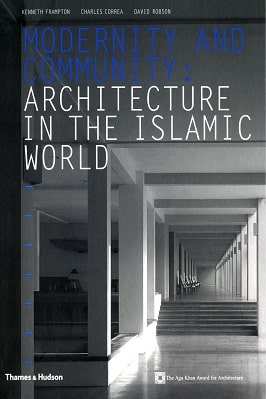
| Modernity And Community Architecture In The Islamic World |
| Kenneth Frampton |
| 166 |
| |
| PDF Direct Download Link |
| Click for Hard Copy from Amazon |
Modernity and Community Architecture in The Islamic World by Kenneth Frampton Charles Correa David Robson
MODERNITY AND COMMUNITY ARCHITECTURE IN THE ISLAMIC WORLD
From the Book: During the 1980s Bawa worked on designs for the new University of Ruhunu near the southernmost tip of Sri Lanka. The magnificent site straddles two hills, giving views across a lake towards the Southern Ocean.
Comprising 50,000 square metres of buildings to accommodate 4.000 students. it was built by Dutch contractors and took eight years to complete.
Bawa’s design deploys over fifty separate pavilions linked by a system of covered loggias on a pre dominantly orthogonal grid, using a limited vocabulary of forms and materials borrowed from the Porto-Sinhalese traditions of the late medieval period.
At the same time, it exploits the changing topography of the site to create an ever-varying sequence of courts and verandas, vistas and closures.
The result is a modern campus, vast in size but human in scale. The projects of the early 1980s brought Bawa international recognition and his work was celebrated in a Mimar book by Brian Brace Taylor in 1986 and in a London exhibition.
But the Parliament building and Ruhunu had left him exhausted. He missed the direct control he had exercised over his earlier projects and spent less and less time in the office in Alfred House Road.
His partner, Poologasundram, had been offended by Bawa’s failure to acknowledge him in the book or exhibition and the two grew apart. After 1989 the practice effectively ceased to function. Bawa was now in his seventies and it was widely assumed that he would retire to Lunuganga and contemplate his garden.
Nothing, however, could have been further fromthe truth. The closing of the office Signalled a new period of creativity, and he began to work from his Bagatelle Road home with a small group of young architects to produce a steady stream of fresh designs.
By now Bawa’s fame had spread far beyond the shores of Serendib and he received many requests to lend his name to projects in the Far East.
He and his young colleagues embarked on a series of ambitious designs: a massive extension to the Hyatt Hotel on Bali; a tropical glasshouse in Singapore: a huge villa hotel on the island of Bintan in Indonesia: a high-rise development in Penang.
Requests for private houses also flooded in and Bawa produced sketches for clients in Ahmedabad, Delhi, Bangalore and Singapore.
None of these projects came to fruition, however, and Bawa treated them as test beds for new ideas, to be used when the opportunity presented itself.
Such an opportunity arose at the end of 1991 when Bawa was commissioned to design a hotel at the foot of King Kasyapa’s rock citadel at Sigiriya in the Dry Zone.
True to form, he rejected the proposed site and persuaded the clients to locate the hotel some fifteen kilometres to the south, on a rocky outcrop above the ancient Kandalama tank. The site was virtually inaccessible and Bawa had to be carried to it on an improvised palanquin.
In its final design the 160bedroom hotel is wrapped around two sides of the rock with rooms facing across the tank towards Sigiriya and Dambulla. The two wings are connected by a cavernous corridor running through the rock from the hotel entrance to the main reception areas.
Bawa’s use of a starkly expressed concrete frame and a flat roof is ideally suited to the location, and the hotel seems to grow out of its site in a simi- lar way to the earlier house at Polontalawa.
The frame Supports a second skin of timber sun breakers, which in turn carries a screen of vegetation, while the flat roof has been transformed into a fantastic tropical garden
To read more about the Modernity And Community Architecture In The Islamic World book Click the download button below to get it for free
or
Report broken link
Support this Website
for websites
Modernity and Community Architecture In The Islamic World